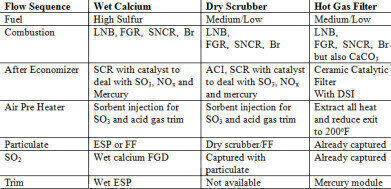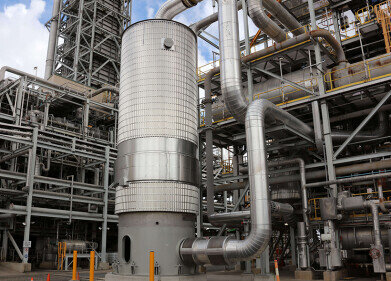-
 LNB= low NOx burner, FGR= flue gas recirculation, Br= bromine addition with fuel. SNCR= selective non-catalytic reduction, CaCO3 = pulverised limestone addition in furnace, ACI= activated carbon injection, SCR= selective catalytic reduction, DSI= dry sorbent injection, HE= heat exchanger, ESP= electrostatic precipitator, FF = fabric filter, FGD= flue gas desulphurisation
LNB= low NOx burner, FGR= flue gas recirculation, Br= bromine addition with fuel. SNCR= selective non-catalytic reduction, CaCO3 = pulverised limestone addition in furnace, ACI= activated carbon injection, SCR= selective catalytic reduction, DSI= dry sorbent injection, HE= heat exchanger, ESP= electrostatic precipitator, FF = fabric filter, FGD= flue gas desulphurisation
Air Clean Up
Sulphuric Acid Mist is a Problem Created by Pollutant Reduction
Jun 15 2015
China is among the countries finding that solution of their NOx and SO2 problems create sulphuric acid mist. The environmental impact is serious and has created an urgency for solution. Companies with the solution have a big opportunity to expand their worldwide reach. McIlvaine (USA) is conducting a discussion of the problem and the solutions on June 18.
Plants which install NOx control systems and scrubbers are creating sulphuric acid mist. The mist plumes are often more visible than the exhaust before the major air pollution control investments. Furthermore, the nearby structures can be quickly damaged by condensing acid mist.
This problem creates a major opportunity for a number of companies. Suppliers of processes, sorbents, catalysts, filters and heat exchangers have experience which is now applicable around the world.
This acid mist problem affects the design of all the other air pollution control equipment. Knowledge of the solution empowers international suppliers. In pursuit of the solution, suppliers have discovered ways to make the entire plant more efficient. So this knowledge is even more valuable.
The first knowledge need involves regulatory implications. SO2 in the flue gas is converted to SO3 in the catalytic reactor used for NOx reduction. The stack gas is cooled in the scrubber and the SO3 leaving the stack is mostly condensed sulphuric acid mist. It is small in total mass but very visible and also destructive to nearby buildings. The mist is often treated as particulate by regulators. Since limits on particulate are an order of magnitude lower than on SO2, the regulatory impact is very significant. There are many unresolved issues on measurement and limits on the mist.
The solutions to the SO3 problem are different for each of three air pollution control processes: Wet Calcium, Dry Scrubber and Hot Gas Filter.
Each of these alternatives will be reviewed in depth during the discussion. Each step in the flow sequence will be analysed. Also site specific variables will be addressed. The discussion will be led by world experts. The webinar will be free to power plants and subscribers to 44I Power Plant Air Quality Decisions (Power Plant Decisions Orchard). There is a charge for others.
Events
IWA World Water Congress & Exhibition
Aug 11 2024 Toronto, Canada
Aug 25 2024 Stockholm, Sweden and online
Sep 03 2024 Mexico City, Mexico
Sep 03 2024 Mexico City, Mexico
Sep 03 2024 San Diego, CA, USA













